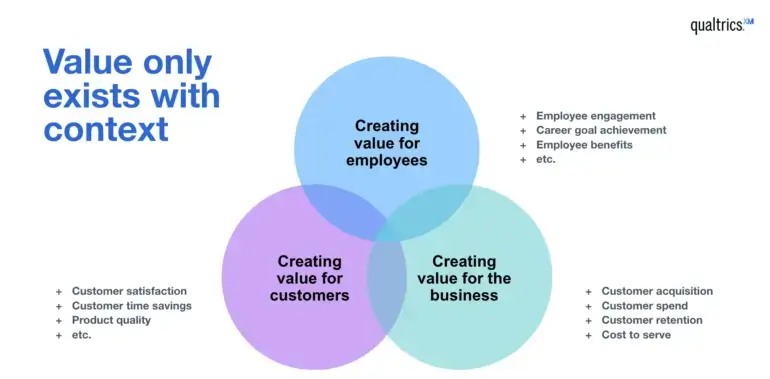Customer Experience
Balancing value to your customers, employees, and business
Value only exists with context. Your customers, employees, and business all value different things. Aligning your focus to what your stakeholders value leads to high-quality, effective decisions.
XM professionals often ask us for assistance in understanding the value delivered by their programs. To do this, we need to clearly define what value means – specifically, what value means to their customers, their employees, and their business (if your organization doesn’t consider itself a business, like a government agency, align this to what your organization values).

Understanding what your stakeholders value is important for helping your organization make high quality decisions. In this article, we’ll provide a simple framework for how to do this.
- Value only exists with context
Your customers value different outcomes than your employees, which value different outcomes than your business. By starting with a clear definition of “value,” you will be better equipped to deliver outcomes that your stakeholders care about.- Value to your customers: Customers value being able to accomplish tasks quickly and easily, feeling connected to the companies they work with, and much more. Increasingly, they have a low tolerance for high effort tasks and expect companies to deliver personalized, seamless, and easy experiences.
- Value to your employees: Employees value things like fair compensation, skill development, and work/life balance. Organizations can also create value for employees by improving processes, systems, and the way work gets done.
- Value to your business: Business value is a function of cash flow. Cash flow is driven by activities like acquiring customers, increasing customer spend, retaining customers, and decreasing the cost to serve customers.
- Double down on win/win’s
Some initiatives create value for more than one type of stakeholder. Help your organization recognize these opportunities to take advantage of them.- Business + Customer: We see many opportunities for customer & business win/win’s in the area of customer support. While we don’t recommend pushing customers to self-service support for every single task, many customers prefer to be able to solve service needs themselves. This includes tasks like changing a flight with an airline, paying bills online, and more. Enabling customers to do this easily also benefits the organization in the form of a decreased cost to serve.
- Business + Employee: Talent acquisition, productivity, and retention are significant sources of opportunity or trapped value for organizations. Employees want their employers to invest in them and provide a positive work environment. When this happens, the organization can avoid undesired employee attrition and realize a substantial return on investment.
- Business + Customer + Employee: Consider what happens when you enable employees to deliver high quality experiences for your customers. In this scenario, you create value for your workforce by investing in them, for your customers by providing an ideal experience, and for your business by retaining top talent and fostering customer retention. Look for these win/win/win’s and help your organization capitalize on them.
- Don’t make bad trades
Some initiatives positively impact one value stakeholder while negatively impacting another. Help your leaders make informed tradeoffs when they need to make difficult decisions.- Customer vs. Business: While some business decisions come at the expense of value to customers, we recommend a measured approach anytime there is conflict between value to the business and value to customers. Sometimes organizations find opportunities to boost profits at the expense of their customers. For example, certain organizations have chosen to make it nearly impossible for customers to cancel contracts. Other examples include limiting the quality of support available to customers. While these policies can persist, they often don’t last forever.
- Employee vs. Business: Businesses occasionally need to make decisions that have a negative effect on employees. For example, while headcount reductions can be the right business decision, they also negatively impact remaining employees. Other areas to pay attention to include employee technology consolidations, reorganizations, benefits policies, and more. Help your organization balance the tradeoffs between short- and long-term benefits, and value to employees and your business.
- Customer vs. Employee: Successful organizations create a balance between value to customers and value to employees. When the focus shifts to customer success at the expense of employee enablement, for example, the likelihood of retaining top talent goes down. Indeed, in industries like healthcare, focusing on patient satisfaction over supporting caregivers can lead to suboptimal medical outcomes, increased complications, and increased frustration among talented providers. While organizations are wise to prioritize customer outcomes, they must be wary of initiatives that achieve this at the expense of their employees.
Take a deeper dive into how much business value is at risk due to poor experiences
